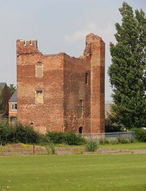Hussey Tower, after remaining quietly for centuries on [now] Skirbeck Road in Boston has become the focus of scrutiny in recent weeks. Heritage Lincolnshire’s phone has been ringing off the hook as journalists take a rare interest in rural fen land history. Reminiscing the affairs of John Hussey, excitement about the Royal Wedding, historians and enthusiasts are scrutinising Megan Markle’s relation to the ill-famed nobleman.
Today, in the corner of playing fields between Boston Grammar School and Boston College Hussey Tower is maintained by local building preservation trust, Heritage Lincolnshire. Originally on the outskirts of town, Hussey Tower was the first building you would pass when approaching by river from the sea. It is now a striking monument surrounded on all sides by civilisation.
The History of Hussey Tower
The tower was Built circa 1450 by Richard Benyngton, who was a wealthy local. Importantly, he was collector of customs for Boston. This meant he could cream off money for himself from the trade taking place in the town’s port, Boston. In 1450 Boston was the biggest, by value of goods, outside of London.
The noticeable architecture was inspired by the nearby Tattershall Castle. Tattershall Castle was built by the even richer Ralph, Lord Cromwell 1430-1450, the treasurer to the King Henry VI. Cromwell and Benyngton served as magistrates together in Boston. In its day Hussey Tower was immediately noticeable because brick was very unusual and expensive, so to build a tower from brick in 1450 was rather like building oneself a skyscraper today. Cromwell and Benyngton served as magistrates together in Boston.

The Namesake of Hussey Tower
Sir John Hussey acquired the tower after Benyngton’s death in 1475, and it is from him that the tower gets its name. He was an important man at the court of Henry VII & Henry VIII, a member of the House of Lords, and was also Sheriff of Lincolnshire (King’s representative in the county).
Hussey’s main residence was the manor house of Old Place in Sleaford, which Heritage Lincolnshire’s archaeologists helped to excavate in 2015 as part of a project led by Old Sleaford Heritage Group community group. It is likely that John Hussey only stayed at the tower when he was visiting Boston on business. Boston was then the county town of the historical subdivision, Parts of Holland, and a major port.
Controversy and Infamy
Hussey fell out of favour with Henry VIII following his break from Rome for failing to react swiftly enough to the Lincolnshire Rising.
At the crux of the uprising was religion controversy. people across Lincolnshire were strongly opposed to the new Church of England and the dissolution of its many wealthy monasteries. This conflict is written onto Lincolnshire’s landscape and the impacts are evident today. (You can see this by visiting Tupholme Abbey, or joining in with Layers of History to investigate the secrets of Revesby.) Today’s rural stillness is testament to the effective dissolution of the monasteries under the Tudor king.
The Lincolnshire Rising in 1536 begun in Louth and was essentially a rebellion against the king, with 40,000 people from Louth, Horncastle, Caistor and Market Rasen marching on Lincoln and occupying the Cathedral. The Duke of Suffolk was dispatched with soldiers and most occupiers fled. The two ringleaders, the Vicar of Louth and a cobbler in the town were captured and hanged in London.
Hussey, who as High Sheriff was responsible for law and order, was arrested and found guilty of treason and executed for not doing his job. Many local gentry sympathised with the rebels and its possible he did too. His lands were confiscated including Hussey Tower. Though the tower has retained the name of it’s ill-fated owner.
Henry VIII gave the tower to the new Boston Corporation, which he founded in 1545 so that it could govern itself without aristocratic interference. The King also gave much of the land belonging to the monasteries/friaries in the town at the same time, thus setting up the council which is still in charge of the Borough today.
The Council still own the tower and we manage it on their behalf.
